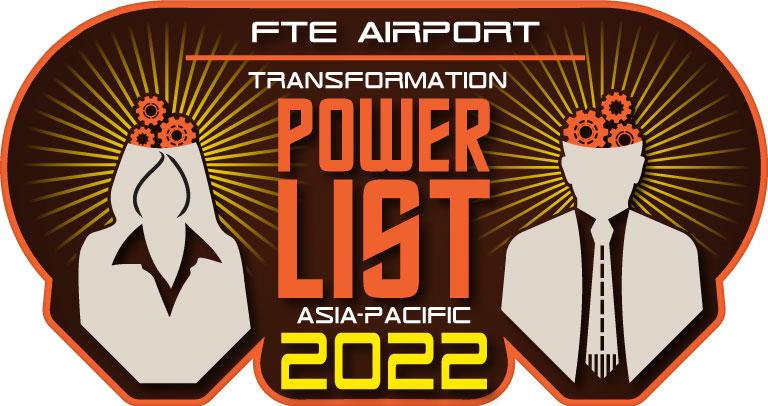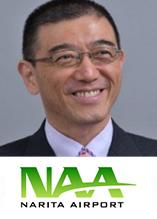
Future Travel Experience is excited to unveil the FTE Airport Transformation Power List Asia-Pacific 2022, following last week’s release of our Airline Power List. Here we shine a light on those who are pioneering new approaches that have the potential to improve travel for passengers and make the industry more efficient and commercially successful. The Asia-Pacific edition champions the most transformative change enablers within the airport industry in the region for their outstanding efforts to lead how their organisation has embraced innovation in order to recover and thrive following the wide-reaching impacts of the COVID-19 pandemic. In recognition of their leadership and achievements, each member of the Power List will receive a complimentary VIP “Golden Ticket” to our FTE APEX Asia Expo, taking place at the world-renowned Marina Bay Sands Expo and Convention Centre, Singapore, on 9-10 November 2022, delivered in partnership with Singapore Airlines, Star Alliance, Onboard Hospitality & Changi Airport Group, which is expected to attract over 2,000 participants from across the region and beyond, thanks to its outstanding line-up of speakers, exhibitors, social events and tours.
Three of the nominees will be awarded with an “Outstanding Achievement” trophy during an official awards ceremony at the event on 9 November, which will provide the perfect opportunity for us to announce and honour our nominees and winners, amongst industry friends and colleagues.
After extensive research into each candidate, we believe the following nine airport executives have been right in the thick of it, facing unprecedented challenges, quickly adapting to the new normal, and charting a new course for their organisations and the wider industry.
George Fanthome, CIO, Bangalore International Airport Limited (BIAL)


Under the theme of “Transforming Tomorrow’s Journey”, FTE APEX Asia Expo brings together an impressive line-up of speakers from the likes of All Nippon Airways, Changi Airport Group, Trip.com Group, SITA, Star Alliance, SriLankan Airlines, Cebu Pacific Air, Lion Air, Pangiam, AirAsia Malaysia, AWS, Narita International Airport Corporation, and many more, who will share ideas and new strategies for improving efficiency, operations, customer experiences, sustainability and revenues.
Lily Lai, Chief Information Officer, Airport Authority Hong Kong

Register for FTE APEX Asia Expo – free to attend >>
Vijaykumar Dayinde, General Manager IT Delivery & Covering CIO, Malaysia Airports

Register for FTE APEX Asia Expo – free to attend >>
Rama Iyer, Head – Innovation, GMR Group

GMR is at the forefront in terms of development and adoption of technological innovations in the region. As one of the largest private airport companies in India, GMR Group is driving several initiatives to enhance business prospects in terms of superior customer experiences, revenue enhancement and cost reduction opportunities as well as agile and efficient internal processes. To foster innovation culture and build a philosophy of open innovation that enables free flow of ideas and resources between GMR and external ecosystem partners, GMR Innovex, the innovation vertical of GMR, was established. It interacts, engages, and collaborates with startups, academia, ecosystem players and other companies in developing both digital and non-digital next generation solutions such as e-boarding, image-based passenger processing and full body scanners. It has institutionalised an “Innovex Fellowship Program” to identify talent early and co-create industry-leading solutions. With a major focus on airports and with a broad array of industries under its span, GMR Group is investing in multitude of technologies like cloud technologies, video analytics, computer vision, data sciences, blockchain, DroneTech, smart tagging, AI/ML, contactless technology, RPA, EV, autonomous, AR/VR, IoT, and Human Machine Interactions (HMI Bots), just to name a few. Leading these efforts is Rama Iyer, Head – Innovation, GMR Group, who is focused on building the entire innovation culture and charter for GMR Airports, while driving the airport of the future vision through innovative products/solutions partnering with startups and building a slew of offerings for airport consumption and beyond.
Register for FTE APEX Asia Expo – free to attend >>
Kittipoj Venunantana, Senior Executive Vice President (Digital and Communications Technology), Airports of Thailand

Register for FTE APEX Asia Expo – free to attend >>
Hideharu Miyamoto, Senior Executive Officer / Deputy Executive Divisional Director of Corporate Planning Division, Narita International Airport Corporation


Hideharu Miyamoto is taking part in the FTE APEX Asia Expo Premium Conference, where he will deliver an insightful presentation on Narita Airport’s journey to establishing an end-to-end biometric passenger experience.
Véronique Austruy, CIO, Kansai Airports

Kansai Airports – operator of Kansai International Airport (KIX), Osaka International Airport, and Kobe Airport – launched the largest airport renovation project in the region for 50 years at Kansai International Airport to support Japan’s post-pandemic recovery. Instead of building a new terminal, Kansai Airports is improving the existing terminal and KIX’s operational efficiency by proactively introducing cutting-edge technologies in a bid to ensure a comfortable, stress-free travel experience for all passengers. Kansai Airports is implementing its own Fast Travel initiative with self-check-in kiosks and self-service bag drop units to streamline departure procedures and increase KIX’s processing capacity, ultimately allowing passengers more time to enjoy the terminal’s facilities before boarding. Furthermore, with an aim to direct passengers to less crowded security areas and improve the security processing capacity, the airport has enabled passengers to see the congestion level and estimated waiting time of each international security checkpoint on their website as well as on the departures floor. This has been made possible with a Passenger Flow Management (PFM) system that uses sensors to recognise and count passengers in a queue and predicts the time required for security and passport clearance, factoring in the number of lanes used for security check and other elements. At the entrance of each security checkpoint, Kansai Airports has installed e-gates to automate the verification of boarding passes, which makes departure procedures even smoother. At security checkpoints, Smart Lanes, the latest security screening machines, have been installed. Moreover, to make the passenger experience more comfortable and secure, various robots are working actively at KIX. A security robot, Secom Robot X2, monitors images using its built-in cameras; cleaning robots enable autonomous cleaning of the terminal buildings. All robots are all equipped with sensors to avoid collisions with passengers and objects. As a measure against COVID-19, the airport also installed and automated robotic PCR testing. Kansai Airports has also set a target to reach net zero greenhouse gas emissions by 2050 for the three airports its operates and recently signed a Memorandum of Understanding (MoU) with Airbus to explore the use of hydrogen.
Register for FTE APEX Asia Expo – free to attend >>
Jonathan Good, Chief Technology and Marketing Officer, Auckland Airport

As borders gradually reopened, Auckland Airport triggered a suite of capital expenditure projects across technology, transport and terminals that will transform the airport into a world-class travel experience with seamless customer journeys. These include the development of a world-class transport centre to be built at the front doorstep of the international terminal – the first of a major new suite of projects about to get underway. Work on the Auckland Airport Transport Hub – a $300 million-plus development – began in June 2022 and it aims to transform how travellers arrive and depart from the main airport terminal, while paving the way for any future mass rapid transit to deliver passengers direct to the airport terminal precinct. The project is also the critical initial step in enabling delivery of the future new combined domestic and international terminal. Along with the Transport Hub, the airport is progressing a suite of major developments that will transform the travel experience, including $185 million enabling works for its combined international and domestic terminal and other projects to ensure a smooth travel experience. The international terminal’s eastern baggage hall will be replaced with the development of a high-tech baggage handling system that will transform the way travellers’ luggage is managed. Auckland Airport has progressed design work for an entirely new baggage handling process, introducing new technology and enhanced operations via an Individual Carrier System (ICS). The automated solution uses real-time data to track baggage as it journeys around back-of-house airport infrastructure. Bags are loaded into intelligent carrier trays tagged with radio frequency identification devices that communicate their location as they travel through an elaborate conveyor network, both speeding up the luggage journey between check-in and aircraft loading as well as reducing the risk of lost bags. The airport has also introduced new digital channels include The Mall, Auckland Airport’s online shopping site. The Collection Point service means off-airport and online tax and duty free purchases can be collected by travellers when they arrive at the terminals. As Chief Technology and Marketing Officer, Jonathan Good is responsible for the strategy and execution of world class technology and marketing programmes to improve the customer experience and ensure operational excellence to meet Auckland Airport’s current and future growth needs.
Register for FTE APEX Asia Expo – free to attend >>
Tom McCormack, Chief Technology Officer, Western Sydney International Airport

Construction of Western Sydney International (Nancy-Bird Walton) Airport is well underway and the airport is on track to begin operations in 2026, with the aim to serve 10 million passengers per year. This transformational infrastructure project will provide employment opportunities for people in the Western Sydney region, meet Sydney’s growing aviation needs, and deliver seamless travel experiences for passengers through smart design, technology and 24/7 service. The infrastructure project, planned and designed with 21st-century thinking, aims to deliver simple and intuitive wayfinding around the terminal that will be easy to navigate, will come together with great customer service to ensure passengers have a stress-free airport experience. Moreover, the airfield will be able to support emerging technologies such as electric aircraft in the future. As a member of the Western Sydney International Executive Team and leading the airport’s technology team, Tom McCormack has the responsibility for the design and implementation of all technology and cyber security of Australia’s first Smart Airport, and is empowered to create a digital-first, technology-enabled airport from scratch.
Register for FTE APEX Asia Expo – free to attend >>

Last week, we announced the nominees for the FTE Airline Transformation Power List Asia-Pacific 2022. Click here to find out which airline executives made it to the top 10.






